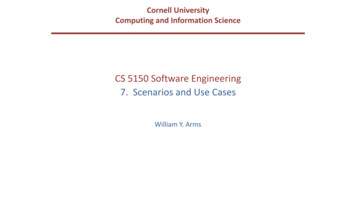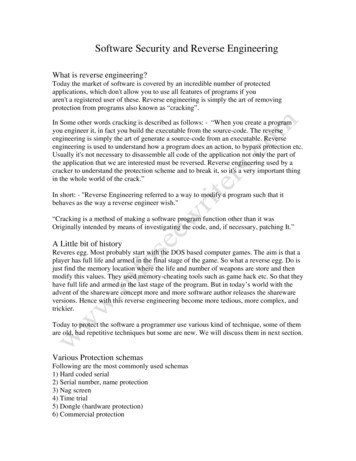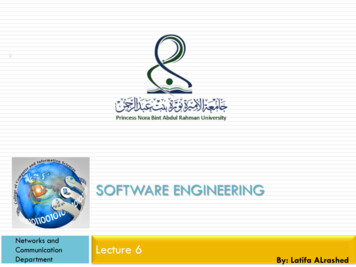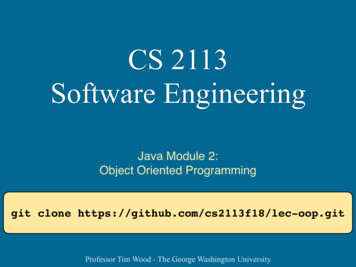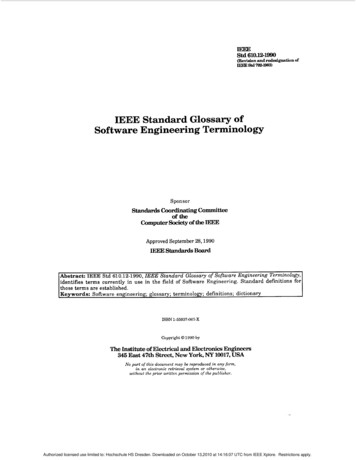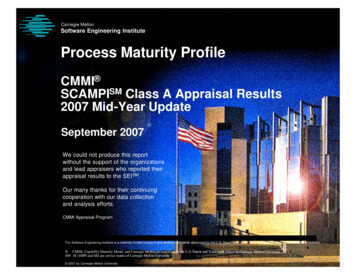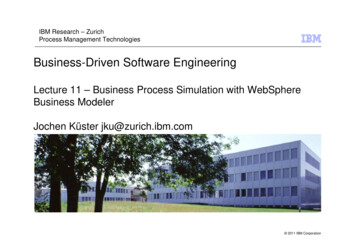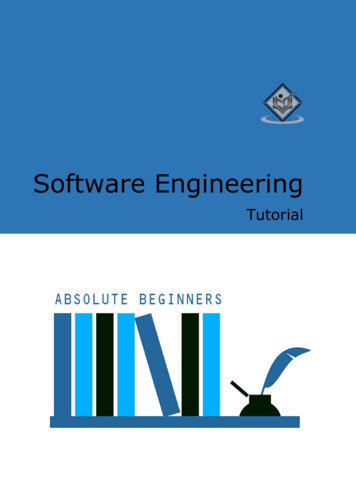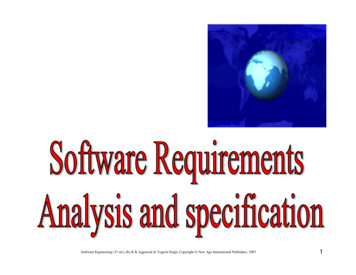
Transcription
Software Engineering (3rd ed.), By K.K Aggarwal & Yogesh Singh, Copyright New Age International Publishers, 20071
Requirement EngineeringRequirements describeWhatnotHowProduces one large document written in natural languagecontains a description of what the system will do withoutdescribing how it will do it.Crucial process stepsQuality of productProcess that creates itWithout well written document-- Developers do not know what to build-- Customers do not know what to expect-- What to validateSoftware Engineering (3rd ed.), By K.K Aggarwal & Yogesh Singh, Copyright New Age International Publishers, 20072
Problem equirementsReviewSRSCrucial Process Steps of requirement engineeringSoftware Engineering (3rd ed.), By K.K Aggarwal & Yogesh Singh, Copyright New Age International Publishers, 20073
Requirement EngineeringRequirement Engineering is the disciplined application ofproven principles, methods, tools, and notations to describe aproposed system’s intended behavior and its associatedconstraints.SRS may act as a contract between developer and customer.State of practiceRequirements are difficult to uncover Requirements change Over reliance on CASE Tools Tight project Schedule Communication barriers Market driven software development Lack of resourcesSoftware Engineering (3rd ed.), By K.K Aggarwal & Yogesh Singh, Copyright New Age International Publishers, 20074
Requirement EngineeringExampleA University wish to develop a software system for thestudent result management of its M.Tech. Programme. Aproblem statement is to be prepared for the softwaredevelopment company. The problem statement may givean overview of the existing system and broad expectationsfrom the new software system.Software Engineering (3rd ed.), By K.K Aggarwal & Yogesh Singh, Copyright New Age International Publishers, 20075
Types of RequirementsTypes of dreamedRequirementsStakeholder: Anyone who should have some direct or indirectinfluence on the system requirements.--- User--- Affected e Engineering (3rd ed.), By K.K Aggarwal & Yogesh Singh, Copyright New Age International Publishers, 20076
Types of RequirementsFunctional requirements describe what the software has todo. They are often called product features.Non Functional requirements are mostly qualityrequirements. That stipulate how well the software does,what it has to tainabilityPortabilityTestabilityFor UsersFor DevelopersSoftware Engineering (3rd ed.), By K.K Aggarwal & Yogesh Singh, Copyright New Age International Publishers, 20077
Types of RequirementsUser and system requirements User requirement are written for the users and includefunctional and non functional requirement. System requirement are derived from user requirement. The user system requirements are the parts of softwarerequirement and specification (SRS) document.Software Engineering (3rd ed.), By K.K Aggarwal & Yogesh Singh, Copyright New Age International Publishers, 20078
Types of RequirementsInterface Specification Important for the customers.TYPES OF INTERFACES Proceduralinterfaces(alsoProgramming Interfaces (APIs)).calledApplication Data structures Representation of data.Software Engineering (3rd ed.), By K.K Aggarwal & Yogesh Singh, Copyright New Age International Publishers, 20079
Feasibility StudyIs cancellation of a project a bad news?As per IBM report, “31% projects get cancelled before theyare completed, 53% over-run their cost estimates by anaverage of 189% & for every 100 projects, there are 94restarts.How do we cancel a project with the least work?CONDUCT A FEASIBILTY STUDYSoftware Engineering (3rd ed.), By K.K Aggarwal & Yogesh Singh, Copyright New Age International Publishers, 200710
Feasibility StudyTechnical feasibility Is it technically feasible to provide direct communicationconnectivity through space from one location of globe toanother location? Is it technically feasible to design a programminglanguage using “Sanskrit”?Software Engineering (3rd ed.), By K.K Aggarwal & Yogesh Singh, Copyright New Age International Publishers, 200711
Feasibility StudyFeasibility depends upon non technical Issues like: Are the project’s cost and schedule assumption realistic? Does the business model realistic? Is there any market for the product?Software Engineering (3rd ed.), By K.K Aggarwal & Yogesh Singh, Copyright New Age International Publishers, 200712
Feasibility StudyPurpose of feasibility study“evaluation or analysis of the potential impact of aproposed project or program.”Focus of feasibility studies Is the product concept viable? Will it be possible to develop a product that matches theproject’s vision statement? What are the current estimated cost and schedule for theproject?Software Engineering (3rd ed.), By K.K Aggarwal & Yogesh Singh, Copyright New Age International Publishers, 200713
Feasibility StudyFocus of feasibility studies How big is the gap between the original cost & scheduletargets & current estimates? Is the business model for software justified when thecurrent cost & schedule estimate are considered? Have the major risks to the project been identified & canthey be surmounted? Is the specifications complete & stable enough tosupport remaining development work?Software Engineering (3rd ed.), By K.K Aggarwal & Yogesh Singh, Copyright New Age International Publishers, 200714
Feasibility StudyFocus of feasibility studies Have users & developers been able to agree on adetailed user interface prototype? If not, are therequirements really stable? Is the software development plan complete & adequateto support further development work?Software Engineering (3rd ed.), By K.K Aggarwal & Yogesh Singh, Copyright New Age International Publishers, 200715
Requirements ElicitationPerhaps Most difficult Most critical Most error prone Most communication intensiveSucceedeffective customer developer partnershipSelection of any method1. It is the only method that we know2. It is our favorite method for all situations3. We understand intuitively that the method is effective inthe present circumstances.Normally we rely on first two reasons.Software Engineering (3rd ed.), By K.K Aggarwal & Yogesh Singh, Copyright New Age International Publishers, 200716
Requirements Elicitation1. InterviewsBoth parties have a common goal--- open ended--- structuredInterviewSuccess of the projectSelection of stakeholder1. Entry level personnel2. Middle level stakeholder3. Managers4. Users of the software (Most important)Software Engineering (3rd ed.), By K.K Aggarwal & Yogesh Singh, Copyright New Age International Publishers, 200717
Requirements ElicitationTypes of questions. Any problems with existing system Any Calculation errors Possible reasons for malfunctioning No. of Student EnrolledSoftware Engineering (3rd ed.), By K.K Aggarwal & Yogesh Singh, Copyright New Age International Publishers, 200718
Requirements Elicitation5. Possible benefits6. Satisfied with current policies7.How are you maintaining the records of previous students?8. Any requirement of data from other system9. Any specific problems10. Any additional functionality11. Most important goal of the proposed developmentAt the end, we may have wide variety of expectations from theproposed software.Software Engineering (3rd ed.), By K.K Aggarwal & Yogesh Singh, Copyright New Age International Publishers, 200719
Requirements Elicitation2. Brainstorming SessionsIt is a group techniquegroup discussionsNew ideas QuicklyCreative ThinkingPrepare long list of requirementsCategorizedPrioritizedPruned*Idea is to generate views ,not to vet them.Groups1. Users 2. Middle Level managers 3. Total StakeholdersSoftware Engineering (3rd ed.), By K.K Aggarwal & Yogesh Singh, Copyright New Age International Publishers, 200720
Requirements ElicitationA Facilitator may handle group bias, conflicts carefully.-- Facilitator may follow a published agenda-- Every idea will be documented in a way that everyone cansee it.--A detailed report is prepared.3. Facilitated Application specification Techniques (FAST)-- Similar to brainstorming sessions.-- Team oriented approach-- Creation of joint team of customers and developers.Software Engineering (3rd ed.), By K.K Aggarwal & Yogesh Singh, Copyright New Age International Publishers, 200721
Requirements ElicitationGuidelines1. Arrange a meeting at a neutral site.2. Establish rules for participation.3. Informal agenda to encourage free flow of ideas.4. Appoint a facilitator.5. Prepare definition mechanism board, worksheets, wallstickier.6. Participants should not criticize or debate.FAST session PreparationsEach attendee is asked to make a list of objects that are:Software Engineering (3rd ed.), By K.K Aggarwal & Yogesh Singh, Copyright New Age International Publishers, 200722
Requirements Elicitation1. Part of environment that surrounds the system.2. Produced by the system.3. Used by the system.A. List of constraintsB. FunctionsC. Performance criteriaActivities of FAST session1. Every participant presents his/her list2. Combine list for each topic3. Discussion4. Consensus list5. Sub teams for mini specifications6. Presentations of mini-specifications7. Validation criteria8. A sub team to draft specificationsSoftware Engineering (3rd ed.), By K.K Aggarwal & Yogesh Singh, Copyright New Age International Publishers, 200723
Requirements Elicitation4. Quality Function Deployment-- Incorporate voice of the customerTechnical requirements.DocumentedPrime concern is customer satisfactionWhat is important for customer?-- Normal requirements-- Expected requirements-- Exciting requirementsSoftware Engineering (3rd ed.), By K.K Aggarwal & Yogesh Singh, Copyright New Age International Publishers, 200724
Requirements ElicitationSteps1. Identify stakeholders2. List out requirements3. Degree of importance to each requirement.Software Engineering (3rd ed.), By K.K Aggarwal & Yogesh Singh, Copyright New Age International Publishers, 200725
Requirements :V. ImportantImportantNot Important but nice to haveNot importantUnrealistic, required furtherexplorationRequirement Engineer may categorize like:(i)It is possible to achieve(ii)It should be deferred & Why(iii)It is impossible and should be dropped fromconsiderationFirst Category requirements will be implemented as perpriority assigned with every requirement.Software Engineering (3rd ed.), By K.K Aggarwal & Yogesh Singh, Copyright New Age International Publishers, 200726
Requirements Elicitation5. The Use Case ApproachIvar Jacobson & others introduced Use Case approach forelicitation & modeling.Use Case – give functional viewThe termsUse CaseUse Case ScenarioUse Case DiagramOften InterchangedBut they are differentUse Cases are structured outline or template for thedescription of user requirements modeled in a structuredlanguage like English.Software Engineering (3rd ed.), By K.K Aggarwal & Yogesh Singh, Copyright New Age International Publishers, 200727
Requirements ElicitationUse case Scenarios are unstructured descriptions of userrequirements.Use case diagrams are graphical representations thatmay be decomposed into further levels of abstraction.Components of Use Case approachActor:An actor or external agent, lies outside the system model, butinteracts with it in some way.ActorPerson, machine, information SystemSoftware Engineering (3rd ed.), By K.K Aggarwal & Yogesh Singh, Copyright New Age International Publishers, 200728
Requirements Elicitation Cockburn distinguishessecondary actors.betweenPrimaryand A Primary actor is one having a goal requiring theassistance of the system. A Secondary actor is one from which System needsassistance.Use CasesA use case is initiated by a user with a particular goal inmind, and completes successfully when that goal issatisfied.Software Engineering (3rd ed.), By K.K Aggarwal & Yogesh Singh, Copyright New Age International Publishers, 200729
Requirements Elicitation* It describes the sequence of interactions between actorsand the system necessary to deliver the services thatsatisfies the goal.* Alternate sequence* System is treated as black box.ThusUse Case captures who (actor) does what (interaction)with the system, for what purpose (goal), without dealingwith system internals.Software Engineering (3rd ed.), By K.K Aggarwal & Yogesh Singh, Copyright New Age International Publishers, 200730
Requirements Elicitation*defines all behavior required of the system, boundingthe scope of the system.Jacobson & others proposed a template for writing Usecases as shown below:1. IntroductionDescribe a quick background of the use case.2.ActorsList the actors that interact and participate in theuse cases.3.Pre ConditionsPre conditions that need to be satisfied for the usecase to perform.4. Post ConditionsDefine the different states in which we expect the systemto be in, after the use case executes.Software Engineering (3rd ed.), By K.K Aggarwal & Yogesh Singh, Copyright New Age International Publishers, 200731
Requirements Elicitation5. Flow of events5.1 Basic FlowList the primary events that will occur when this use case is executed.5.2 Alternative FlowsAny Subsidiary events that can occur in the use case should beseparately listed. List each such event as an alternative flow.A use case can have many alternative flows as required.6.Special RequirementsBusiness rules should be listed for basic & information flows as specialrequirements in the use case narration .These rules will also be usedfor writing test cases. Both success and failures scenarios should bedescribed.7.Use Case relationshipsFor Complex systems it is recommended to document the relationshipsbetween use cases. Listing the relationships between use cases alsoprovides a mechanism for traceabilityUse Case Template.Software Engineering (3rd ed.), By K.K Aggarwal & Yogesh Singh, Copyright New Age International Publishers, 200732
Requirements ElicitationUse Case Guidelines1. Identify all users2. Create a user profile for each category of users includingall roles of the users play that are relevant to the system.3. Create a use case for each goal, following the use casetemplate maintain the same level of abstraction throughoutthe use case. Steps in higher level use cases may betreated as goals for lower level (i.e. more detailed), subuse cases.4. Structure the use case5. Review and validate with users.Software Engineering (3rd ed.), By K.K Aggarwal & Yogesh Singh, Copyright New Age International Publishers, 200733
Requirements ElicitationUse case Diagrams-- represents what happens when actor interacts with a system.-- captures functional aspect of the system.Actor-- ActorsUse CaseRelationship betweenactors and use caseand/or between theuse cases.appear outside the rectangle.--Use cases within rectangle providing functionality.--Relationship association is a solid line between actor & usecases.Software Engineering (3rd ed.), By K.K Aggarwal & Yogesh Singh, Copyright New Age International Publishers, 200734
Requirements Elicitation*Use cases should not be used to capture all the details of thesystem.*Only significant aspects of the required functionality*No design issues*Use Cases are for “what” the system is , not “how” the systemwill be designed* Free of design characteristicsSoftware Engineering (3rd ed.), By K.K Aggarwal & Yogesh Singh, Copyright New Age International Publishers, 200735
Use case diagram for Result Management SystemMaintain StudentDetailsMaintain SubjectDetailsData Entry OperatorMaintain ResultDetailsLoginAdministrator/DRGenerate ResultReportsView ResultsStudent/TeacherSoftware Engineering (3rd ed.), By K.K Aggarwal & Yogesh Singh, Copyright New Age International Publishers, 200736
Requirements Elicitation1. Maintain student DetailsAdd/Modify/update students details like name, address.2.Maintain subject DetailsAdd/Modify/Update Subject information semester wise3.Maintain Result DetailsInclude entry of marks and assignment of credit points for eachpaper.4. LoginUse to Provide way to enter through user id & password.5. Generate Result ReportUse to print various reports6. View Result(i) According to course code(ii) According to Enrollment number/roll numberSoftware Engineering (3rd ed.), By K.K Aggarwal & Yogesh Singh, Copyright New Age International Publishers, 200737
Requirements Elicitation (Use Case)Login1.1 Introduction : This use case describes how a user logs intothe Result Management System.1.2 Actors :(i)(ii)Data Entry OperatorAdministrator/Deputy Registrar1.3 Pre Conditions : None1.4 Post Conditions : If the use case is successful, the actor islogged into the system. If not, the system state is unchanged.Software Engineering (3rd ed.), By K.K Aggarwal & Yogesh Singh, Copyright New Age International Publishers, 200738
Requirements Elicitation (Use Case)1.5 Basic Flow : This use case starts when the actor wishesto login to the Result Management system.(i) System requests that the actor enter his/her name andpassword.(ii) The actor enters his/her name & password.(iii) System validates name & password, and if finds correctallow the actor to logs into the system.Software Engineering (3rd ed.), By K.K Aggarwal & Yogesh Singh, Copyright New Age International Publishers, 200739
Use Cases1.6Alternate Flows1.6.1Invalid name & passwordIf in the basic flow, the actor enters an invalid nameand/or password, the system displays an error message. Theactor can choose to either return to the beginning of the basicflow or cancel the login, at that point, the use case ends.1.7Special Requirements:None1.8Use case Relationships:NoneSoftware Engineering (3rd ed.), By K.K Aggarwal & Yogesh Singh, Copyright New Age International Publishers, 200740
Use Cases2.Maintain student details2.1Introduction :Allow DEO to maintain student details.This includes adding, changing and deleting EO must be logged onto thesystem before this use case begins.Software Engineering (3rd ed.), By K.K Aggarwal & Yogesh Singh, Copyright New Age International Publishers, 200741
Use Cases2.4Post-conditions: If use case is successful, studentinformation is added/updated/deleted from the system.Otherwise, the system state is unchanged.2.5Basic Flow: Starts when DEOadd/modify/update/delete Student information.wishesto(i) The system requests the DEO to specify the function,he/she would like to perform (Add/update/delete)(ii) One of the sub flow will execute after getting theinformation.Software Engineering (3rd ed.), By K.K Aggarwal & Yogesh Singh, Copyright New Age International Publishers, 200742
Use Cases If DEO selects "Add a student", "Add a student" sub flow willbe executed. If DEO selects "update a student", "update a student" sub flowwill be executed. If DEO selects "delete a student", "delete a student" sub flowwill be executed.2.5.1 Add a student(i) The system requests the DEO to enter:NameAddressRoll NoPhone NoDate of admission(ii) System generates unique idSoftware Engineering (3rd ed.), By K.K Aggarwal & Yogesh Singh, Copyright New Age International Publishers, 200743
Use Cases2.5.2 Update a student(i) System requires the DEO to enter student-id.(ii) DEO enters the student id. The system retrieves anddisplay the student information.(iii) DEO makes the desired changes to the studentinformation.(iv) After changes, the system updates the student record withchanged information.Software Engineering (3rd ed.), By K.K Aggarwal & Yogesh Singh, Copyright New Age International Publishers, 200744
A

